Abstract
When we think about sustainability, the most common understanding relates to the environment, economy, and social issues. Environmental art is increasingly becoming a medium to address environmental challenges that offer many opportunities when included in the work of sustainable development. The research methodology explores the relevance of art and design projects using recycled or waste materials in landscape park architecture for sustainability, helping to preserve natural resources and protect the environment. Additionally, designing a landscape park in Al-Ahsa Governorate using recycled waste materials will educate society about sustainability via artistic creativity. The applied side, designing a group of artworks, was completed using computer graphic programs and AI systems to improve the visual landscape’s architectural aesthetics through sculpture parks, public sets, etc. The result provides evidence that parks in Al-Ahsa lack artwork, color, and the application of recycled materials in landscape facilities which make a negative contribution to the quality of life of society. Using recycled and waste materials in artwork will contribute to a healthy ecological system and preserve natural resources. Urban landscape designers should consider the addition of parks, land formation, growing plants, artwork, and cheerfully colored furniture with other landscape architecture facilities, which will improve people’s moods and the appearance of cities.
1. Introduction
Due to worldwide concern about health and environmental resources, there has been a notable, encouraging increase in the utilization of waste material, particularly in developed nations. Recycling unwanted or waste materials for utilization in new products is a solution to reducing waste materials instead of employing furnaces for burning trash, producing different dioxin compounds. Therefore, it is necessary to understand the scope and characteristics of recycling technologies to avoid the consequences of burning waste []. The recycling industry is one of the many present in the manufacturing sector. The sectors of economy, environment, and society continue to support several efforts to advance sustainability and the circular economy []. In 2016, Saudi Arabia announced the Kingdom’s Vision 2030, which includes an ambitious plan as shown in Table 1. The plan implies protecting the environment and developing the concept of waste management for sustainable solutions through what is known as the circular economy which aims to convert the recycled product into valuable resources [].

Table 1.
Targets for the waste management sector in the Kingdom by 2035 [].
The concept of sustainability must take into account the ways in which social, economic, and environmental factors interact from a comprehensive and long-term viewpoint []. In the Voluntary National Review to the United Nations High-Level Political Forum 2018 on sustainable development, Saudi Arabia considered waste management and treatment programs to be one of the most important environmental issues. The Voluntary National 2018 report of Saudi Arabia was based on international guidelines and environmental preservation strategies. The report highlights developing strategies for achieving sustainable urban development, safeguarding natural resources and biodiversity, plans on improving the effectiveness of governmental institutions, and raising the standard of public services. The developing strategies plan will be achieved by the national entities including the government sector and non-governmental organizations to face environmental challenges in order to fulfill Saudi Arabia’s 2030 Agenda for sustainable development’s goals []; Figure 1. In terms of objectives and results, the future Saudi cities program is closely tied to KSA’s strategic vision 2030. In response to the urban challenges that emerge due to rapid growth in population and consumption, as well as to support the country’s urban strategy to attain a balanced development, the strategic planning framework seeks to develop a new vision for sustainable urban development, in line with world-class standards.
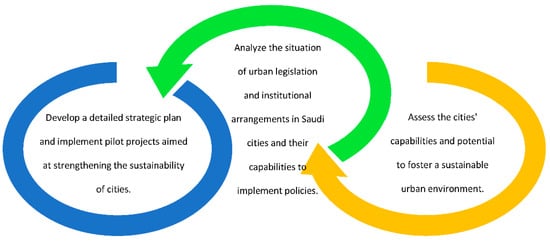
Figure 1.
National Saudi Arabia’s Strategy alignment with Kingdom Vision 2030 [].
In terms of sustainability, environmental sustainability, horticulture, and aesthetics are all components of the landscape design. According to the Florence Convention, the landscape is considered to be the “result of action and interaction of natural and/or human factors” []. Strategic design of the landscape using recycled waste materials will reduce the impact of society’s pressures on the environment, balance the ecological systems [], and decrease many various types of pollution [], resulting in a natural and healthy environment []. Due to our excessive natural resource consumption, the application of recycling system management will result in resource conservation, create employment, save energy, and promote environmental quality [,]. Additionally, it will reduce economic expenditure and increase the value of national output and income, reflecting the benefit of economic growth on society.
Creating beauty in landscape architectural design using waste or recycled materials through artistic works will enhance the aesthetic value of the natural environment. Art embodies the interaction between people and their surroundings. Dissanayake points out that arts and culture have been essential to our growth as humans []. Throughout art history, there has always been a strong connection between art and the environment. Artists convey this connection through their work. People, whatever their culture, are interested in the arts and practice it in one way or another. Therefore, creating artwork from waste or recycled materials will help the government to implement waste management and treatment programs. In addition, this will aid in improving scenes of landscape parks through artwork, providing positive and comfortable living conditions for the people in society.
The idea of designing a landscape in Al-Ahsa Governorate by applying artwork from recycled waste materials is aimed not only to increase societal awareness of the value of sustainability in landscape architecture [], but also to educate and adapt society via artistic creativity about the sustainability awareness []. Additionally, this approach will preserve natural resources rather than destroying the ecosystem structure, and raise societal awareness of the importance of landscapes []. The preservation is not only to benefit the present but also future generations []. The artworks we created and designed used recycled waste materials such as plastics, crushed glass, steel, timbers, concrete, tires, recycled concrete, and wood reuse, to design sculpture parks, public sets, tables, waterfalls, lights, and other landscape elements in Al-Ahsa squares and public gardens. Such artwork attempts to provide meaning and value to the surrounding landscapes. Comprehension of landscapes as unique social identities will change society’s culture and shift the perspective from the scientific approach to landscape design, which mostly relies on geographical and ecological typologies [].
1.1. Problem of Research
Increasing product manufacture generates more waste, which raises environmental concerns about toxic compound threats and the depletion of natural resources. To face this problem, we need integrated collaboration between all disciplines. The utilization of a recycling system of waste materials in new products is a considerable solution to reduce waste materials, and preserving natural resources will protect the environment from harmful pollution. Al-Ahsa parks lack the culture of artwork in urban landscape structures and cheerful colors in landscape architecture. The main point we discuss herein is the challenges facing academics in looking to the future by utilizing recycled or waste materials in artwork in Al-Ahsa governorate parks to enhance the sustainable value and create a visually appealing, functional, and ecologically sound design.
1.2. Research Objective
The main idea behind this experiment is to:
- Assess the current situation of Al-Ahsa parks in order to provide artistic design concept recommendations.
- Explore the relevance of artwork design in landscape construction from recycled or waste materials to contribute to a healthy ecological system and to preserve natural resources.
- To raise societal awareness and enable understanding of sustainable development by utilization of recycled material in artworks.
- Improve the visual aesthetics of landscape architecture design through artwork to enhance the visual aesthetic value of society.
2. Materials and Methods
The concept of this research is to explore the worldwide concern with health and environmental resources through an increase in the utilization of waste material. Therefore, this study discusses and focuses on the relevance of art and design projects using recycled or waste materials in landscape park architecture for sustainability. Four parks were selected as the most famous in Al-Ahsa public spaces; Figure 2. We visited the King Abdullah Al-Ahsa Park, the Jawatha Park, the Mahassen Park-Aramco, and the Endowments Park in the city of Al-Ahsa to understand the characteristics and landscape architecture facilities of the parks. Designing of a group of artworks using recycled and waste materials was performed using computer graphic programs and AI systems to improve the visual landscape aesthetics through park sculptures, public sets, tables, waterfalls, light units, and other landscape accessories. The developed design criteria particularly focused on applied artwork from recycled and waste materials, contributing to raising society’s awareness of sustainability through art. In addition, enhancement of the landscape construction with cheerful colored artwork to add visual pleasing to the landscape scenes was considered.
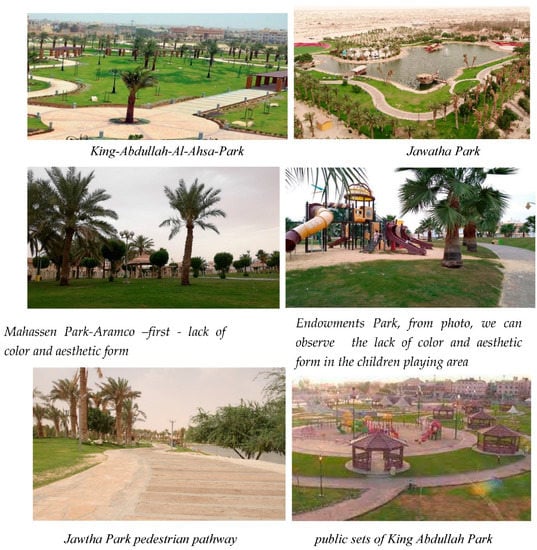
Figure 2.
Different landscape park views from Al-Ahsa Governorate show that parks miss the visual aesthetics space, artwork, accessories, and furniture, which form the character that impacts people’s emotions.
Material has a significant role when creating outdoor art, always playing a meaningful role in the structure and composition of any type of ecological landscape design. The material commonly refers more to the concept rather than to the object, elicits a reaction, and simplifies the understanding of the meaning used in its creation. The materials suggested in the design varied from natural and industrial recycled or waste materials. Each material has its own splendor and special character that highlights the artwork with characteristics and qualities that offer the artwork its spirit, making it distinct. Therefore, knowing the materials and techniques used to create the artwork would enhance and change public perception and appreciation towards using recycled materials. Such approach can also support governments in their strategic plans regarding health, environmental sustainability and preservation of natural resources.
2.1. Geographical Environment and Landscapes in Al-Ahsa
The Al-Aḥsa oasis located in the eastern part of the Arabian Peninsula is the largest governorate in terms of area in Saudi Arabia’s eastern province. It is one of the largest oases in the world with world-renowned date palms []. It lies about 40 miles (65 km) west of the Persian Gulf. It spans around 530,000 km2, or 24% of the entire land area of Saudi Arabia, and 68% of the eastern region []. The region has a sub-tropical desert climate, characterized by cold, reasonably dry winters and extremely hot, dry summers.
The oasis is a series of properties that include historical buildings, urban fabric, and archaeological sites together with gardens, canals, springs, wells, and a drainage lake. The name of the city originates from the nature of its land: in Arabic, Al-Ahsa is a plural word of “Al-Hisa”, which refers to the accumulated sand with a solid base underneath. When it rains, the sand prevents the sun from drying up the water []; also, “Ahsa” means the sound of underground water. Al-Ahsa Governorate is witnessing massive urban development, with a good infrastructure network []. Al-Ahsa is one of the very famous and wealthy governorates in traditional handcraft production that covers all the requirements of life and represents one of the historical legacies that have been practiced generation after generation. The city became a member of the UNESCO Creative Cities Network in late November 2015 in the field of handicrafts and folk arts [], and in 2019, it was chosen as the capital of Arab tourism to solidify its position among Arab cities.
2.2. Recycling Term
The term “recycling” has multiple definitions including “recovery and utilization” []. Recovery is the process of diverting and collecting waste material from landfills, incinerators, and other disposal facilities. Utilization is the process of turning waste material that has been redirected into a new kind of product, valuable materials and goods products []. Generally, the objective of recycling unwanted or waste materials is to extend the lifespan of materials. This entails making them last longer than the products they are a part of, i.e., materials can become secondary raw materials again after processing []; such materials are reused components conserving natural resources by an ideal action of sequence in the recycling context. It is necessary to consider product manufacture and construction early, since product inception, to achieve recycling process successfully []; see, for example, “Product Lifecycle”. The development of resource-saving technologies of recycling and utilization of waste material will lead to the notion of sustainable development.
The level of recycling unwanted or waste material reprocessing can be classified as follows []:
Unchanged physical and chemical structure, such as end-of-life tires used as fenders.
Physical structure destroyed but not chemically, such as melting and reprocessing of metals.
Structure destroyed physically and chemically, such as de-polymerization of plastic into monomers.
2.3. The Role of Artist in Environmental Sustainability
Sustainability is a phenomenon of complex concept notion that is always changing and connecting the development to both environmental and socioeconomic problems []. Therefore, connecting art with science today is a necessary means to achieve accurate sustainability practices in society. Art has a significant role in raising public awareness on the subject of sustainability. Through artistic actions that creatively use scientific facts, it is possible to simultaneously create tacit knowledge of sustainability []. Kindvall included in his survey a question to some artists about their thoughts on their work contributing to environmental sustainability []. The artists responded that nature and the environment stimulate and foster contemplation on the related issues. They can provide opportunities for people to view things differently and provide experiences that are outside of their comfort zones, which can generate a “multiplier effect” and cause a shift in understanding environmental sustainability []. Art and environmental landscape contribute to advancing sustainable development culture, acting as a catalyst for social awareness and changing a sustainable future of recycled and waste materials. The creative artwork in the park’s planning of the Al-Ahsa governorate may address social and neighborhood needs which provide community members with new perspectives, in shaping the future of their society []. Artistic activities can play an important role in most common urban problems, such as the degradation of the social, economic, and environmental contexts [].
2.4. Form, Color, and Space in Landscape Architecture
In the context of art, “form” describes three-dimensional objects and can be used to describe shape, structure, or overall visual appearance. Sculpture in the language of contemporary art is represented as a term of the aesthetical form; Figure 3. Sculpture or form in modern arts is no longer limited to the shapes of cylinders, pyramids, and spheres, or, as in the past, to the figurative composition of human figures drawn from different anatomical canons []. The formalist vocabulary of sculpture developed into a “new language of vision” and moved away from the simulation of natural surfaces and features, carrying on the evolutionary trends []. According to one of the definitions of modern landscape architecture, it is a “synthesis discipline that successfully achieves a consensus between function, structure, and forms inside the constructed space, allowing human life to evolve in an organized manner” []. In landscape architecture, form, color, and space are presented to solve the issues of function, purpose, and context not as ends in themselves, but as processes to stimulate activities, elicit responses, and express meaning environmental sustainability []. Therefore, form and colors essentially connect with the surroundings, and the artist cannot create their artwork without considering the location of the work and its connection with its surroundings; Figure 4. Form and colors play a significant role in daily life, having an impact on people’s emotions in both biological and cultural spheres. People frequently use color to symbolize a state of mind or an emotional quality. This happens through vision, via a person’s endocrine system, causing changes in their hormone levels and moods []. In addition, color has a significant role in enhancing the appearance of the user’s sense of space, mass, and other environmental elements []. The influence is enhanced when the colors used in the general interior design, accessories, and furniture are fused to form the character effect perceived by the audience [].

Figure 3.
The designs show the relation of the form and color in the surrounding environment.
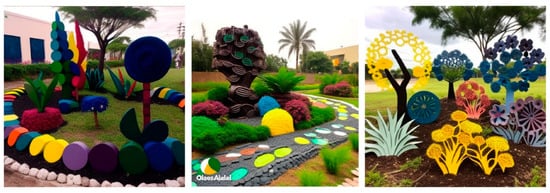
Figure 4.
Sets of designs show that using waste materials like plastic can bring joy, and recycled concrete in-ground pavements can influence human preference and perception.
3. Results and Discussion
Since most of the world’s civilization is focused on the environment and sustainability, waste management requires significant public support and understanding from governments [].
Saudi Arabia is witnessing an industrial boom, an increase in population growth, and an increase in the number of new cities, which has led to an increase in pollution and waste rates. Therefore, solid waste management has become a major daily challenge for the government; Table 2 []. The estimated daily per capita waste production rate in Saudi Arabia is 1.5–1.8 kg; Table 3 [].

Table 2.
The volume of waste in the Kingdom of Saudi Arabia [].

Table 3.
The components of municipal solid waste in the Kingdom of Saudi Arabia [].
Cultural behaviors in communities have a significant impact on the ways in which the environment is treated. The challenge of sustaining human existence is directly related to the preservation of the environment []. Sustainable materials might be a viable solution to this challenge. Recycling and reusing waste materials is an effective approach to minimizing the negative effects of human activity on ecological system destruction. As a result, the fear of depletion of natural materials and environmental concerns drive scientists on a quest for substitute materials.
The goal of recycling unwanted or discarded materials is extension of the longevity of materials, making waste materials last longer than the things they are a part of. This requires early consideration of product manufacture and construction from product inception, which is essential to successfully achieving the recycling process. In addition, recycling and using waste material saves our natural resources and balances the ecological systems, reducing different forms of pollution and enhancing microclimates, holding enormous potential for improving the economy and the environment, and ensuring a visually pleasing sense of the lifestyle of society.
From the perspective of sustainable development, art is an effective medium to protect the environment by using recycled material. In addition, this helps to educate society via artistic creativity and awareness of sustainability development. Creating artwork in landscape architecture from recycled materials is a strategy that is consistent with the fundamental concepts of sustainable development and contributes to educating and supporting the sense of society via public artwork. Although colors and form have powerful emotional and psychological effects on viewers (Figure 5), a product’s color and form can either attract or repel the audiences. The philosophy of using sculpture parks and other accessories with cheerful colored furniture elements in the planning of Al-Ahsa governorate parks is still neglected too often. The artworks are considered unnecessary in urban development policies. Through the research survey, we observed that all parks, including the King-Abdullah Park, the Jawatha Park, the Mahassen Park-Aramco, and the Endowments Park of Al-Ahsa City lack colors except green, natural wood color, and dark metals. The pedestrian pathway is made from concrete, and all the park facilities lack color (Figure 1). Al-Ahsa Parks need to use artwork in the physical facilities of the landscape, such as creative designs of public seating (Figure 6), and covered private seating (Figure 7) from recycled material. This artwork and other landscape accessories act as social development educators and improve the quality of the built landscape environment. In addition, they contribute to the reduction in the environment consequences of accumulating different waste materials, encouraging the preservation and safeguarding of cultural heritage []. In addition to the color and form having powerful emotional and psychological effects on attracting viewers, they can also repel audiences. Therefore, the best effects in landscape architecture design should be carefully studied by landscape designers []. Color and form have a universal appeal to people; therefore, landscape designers can utilize color values to arouse positive emotions in society.
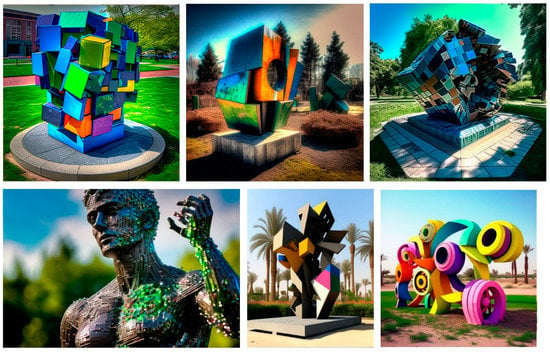
Figure 5.
Suggested sculpture using recycled and waste materials such as plastic and scrap metal showing that the landscape architecture scenes can change the aesthetics of space through form and color.
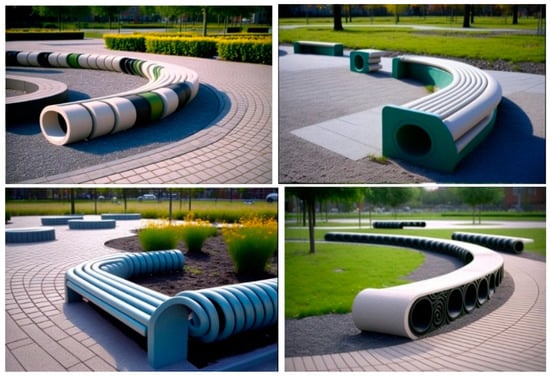
Figure 6.
Group of designed park seats that can be constructed using waste material such as drainage pipes mixed with recycled concrete and recycled plastic.

Figure 7.
Group of public sets. The idea can be applied using recycled plastic and concrete. An example of revolutionary developments of form and materials in visual arts.
Among the elements of artwork, materials play a significant role in landscape architecture that elicits a reaction, promotes comprehension in the viewer, and adds significance to the landscape environment. Materials might increase or decrease their significance or value, and include a number of relationships that are not present in the fundamental form. The form of the employed materials has evolved continuously from ancient times until the industrial revolution, influencing both art forms and art methods in expression. Each material has a unique magnificence and distinctive quality that enhances the artwork with traits and attributes that offer it personality and distinguishability. Knowing the materials and methods utilized to make the artwork therefore influences the public opinion, perception of, and satisfaction with employing recycled materials. Even the relatively ordinary art made from recycled or waste materials can be employed in a variety of ways to create a wide range of impressions. Artists experiment with the qualities of materials, respecting their physical and functional boundaries (Figure 8).
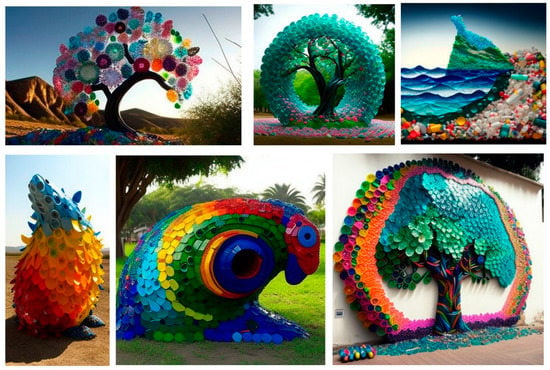
Figure 8.
Different artwork design transforms waste into a creative product.
At present, the outcomes of artwork are concerned with society and connected to the urban and public arts more than in the past. Over the past 20 years, environmental psychology has significantly advanced the field of the study of people–environment interactions. The goal is for decision-makers to have an understanding of the relationship between individuals and their surroundings []. The successful planning, design, administration, and usage of the environment are recognized as requiring an understanding of the many perspectives, such as attitudes, values, and behaviors of individuals and groups. Collaboration across the disciplines of architecture, civil engineering, surveying, landscape contracting, and artist specialty is recommended from the conceptual phases to the final construction in landscape design. The new concept of contemporary art through form and idea gave rise to the convergence of interrelationships and interests in physical manifestations with urban landscape in an integrated and organic relationship to enhance social life. Therefore, the role of visual arts throughout history cannot be overlooked. Because of its universal communication language, it can be presented to a broad audience. Art is an inexhaustible human activity that serves as a universal and lasting reaction to the world we live in. Outdoor art is a creative feature with attractive qualities in urban landscape living. It contains “cultural landscape” and “cultural route”, joined to form an aesthetic artistic representation of an urban architectural setting []. Outdoor art composes the overall urban landscape construction, connecting environmental behavior, form, and aesthetic qualities. For a very long time, scholars of the arts have questioned the prevailing paradigms, impacted and educated people, and conveyed problems []. Artists can simultaneously create innovative artwork to develop people’s aesthetic awareness and enhance their environmental consciousness []. Art practices have proven to improve survival by fostering community, interdependence, and collaboration. Dissanayake, for example, claims that in order for our human nature to be realized to its utmost, art must exist [].
4. Conclusions
Solid waste management is a major daily challenge for governments. In order to maintain world health and environmental resources, we have to encourage recycling and utilization of waste material. At the United Nations Forum 2018 on Sustainable Development, Saudi Arabia attached great importance with an ambitious strategic plan for achieving sustainable urban development and raising the standard of public services. The strategy plan sets challenges in order to achieve Saudi Arabia’s 2030 Agenda for sustainable development goals. Although science is a necessary means to achieve accurate sustainability practices in society, it is necessary to achieve awareness-raising among all segments of society to reduce the spread of waste and reutilize materials if possible. Art also plays a significant role in the subject of sustainability via incorporation of recycled material into artwork ideas. In the context of art, form and landscape architecture contribute to advancing sustainable development, acting as a catalyst for social awareness and changing the culture of sustainability. The Al-Aḥsa Oasis, the model of this study, is one of the largest of its kind, world-renowned for its date palms; it is also the largest governorate in terms of area in Saudi Arabia. The governorate includes a series of properties, traditional handicraft production, historical buildings, and archaeological sites together with gardens, canals, springs, wells, and a drainage lake. Al-Ahsa governorate is witnessing massive urban development with a good infrastructure network.
The study of the King-Abdullah Park, the Jawatha Park, the Mahassen Park-Aramco, and Ethe ndowments Park of Al-Ahsa City provides evidence of artwork not being used in the park landscape architecture. This lack of landscape artwork in these parks makes negative contributions to the impact on the quality of life. The study explored the relevance of artwork design made from recycled or waste materials in urban settings for improving the urban landscape architecture aesthetically, supporting governments in their strategic plans to save ecological systems. The outcome of applying artwork in the landscape of these parks using recycled or waste materials conveys a deeper meaning of sustainable living in society, educating society through visually pleasing structures, preserving natural materials, and improving the ecological urban landscape construction. It is important to note that artwork in urban landscapes aims to advance sustainable culture and communicate relevant messages to the public through recycled material. Increasing aesthetic awareness of society can develop a new practice and concept of recycling material that could help sustain the environment.
An urban landscape designer should consider that the structural plan of landscape parks does not only depend on the ecological typologies and the growing plants. Aesthetic landscape design is not only developed by the scientific approach. More connections between ecological public art and landscape architecture in Al-Ahsa are needed. Therefore, landscape designers should take into consideration the use of sculpture parks, cheerful, colored furniture elements, and other landscape facilities in the planning of Al-Ahsa Governorate parks. We might aim to comprehend landscapes as strategies to raise the public’s understanding of sustainable culture through the usage of recycled or waste material in creative artwork.
Modern landscape architecture is a synthesis field that successfully reconciles function, structure, and forms inside the built environment. Artwork in landscape architecture associates with its surrounding environment, always presented to solve the problem related to function and context to promote endeavors, responses, and communicate meaning to society. Artwork has a significant role in enhancing the appearance of the user’s sense of space; it is frequently used to symbolize a state of mind or influence people’s emotions, both biologically and culturally. Therefore, improving the perception of the surroundings of the cities can support environmental sustainability in controlling the environment and improve the aesthetic visual image of the city.
The value of art in advancing culture and society plays an important role in solidifying the fundamental principles of sustainable societies and a city’s evolution. Vision can have an impact on a person, causing changes in their moods. Form, color, and space should be used in landscape architecture to address problems related to function, purpose, and context. Form and colors are fundamentally tied to their environment, and the artist cannot produce work without taking into account the location and the way the artwork interacts with the particular external circumstances. Colors and form play important roles in daily living. People naturally utilize color to represent emotional or mental conditions. The appearance of the user’s perception of space, mass, and other landscape architecture components is significantly improved by form and color. The material in landscape architecture also has a significant role in artwork elements, similarly to color and form; it is always an important part of the framework and composition of any ecological landscape design, eliciting an emotional response, aiding in understanding, and characterizing the landscape context. An objective, decision-making process can provide a result that is in accordance with the requirements of the public when dealing with creative artwork produced from recycled materials.
Finally, the utilization of recycled materials and waste should be expanded in the educational sector, especially in the art sector. Artists and any groups of society that can contribute to adopting the idea of recycling must be enabled to use such materials. Governments and officials should provide guidance to people and experiences on ways to reuse waste materials. Different sectors should encourage activities related to waste reuse instead of using natural resources, if possible, periodically organizing, for example, competitions for different sectors to encourage innovation based on waste. In the context of social–environmental change, the necessity for efficient communication, public outreach, and education to boost support for group action and behavior change is maybe at its highest. The relationship between art and environmental sustainability using recycled and waste materials can be more profound through more education and environmental awareness.
Author Contributions
H.T.A. conceived the research idea and led the research team on this project, taking the lead in the planning, execution, data collection, writing of the paper and execution of the project designs. A.M.A. supervised the project and partook in the data collection and execution of the designs. All authors have read and agreed to the published version of the manuscript.
Funding
This research was funded by Deputyship for Research and Innovation, Ministry of Education in Saudi Arabia (No. INST066).
Institutional Review Board Statement
Not applicable.
Informed Consent Statement
Not applicable.
Data Availability Statement
Not applicable.
Acknowledgments
The authors extend their appreciation to the Deputyship for Research and Innovation, Ministry of Education in Saudi Arabia, for funding this research work (No. INST066).
Conflicts of Interest
The authors declare no conflict of interest.
References
- Liu, X.; Xie, Y.; Sheng, H. Green waste characteristics and sustainable recycling options. Resour. Environ. Sustain. 2023, 11, 100098. [Google Scholar] [CrossRef]
- Mwanza, B.G. Introduction to Recycling; Springer: Singapore, 2021; pp. 1–13. [Google Scholar]
- GOV.SA. Environmental Protection in the Kingdom of Saudi Arabia. 2023. Available online: https://www.google.com/url?sa=t&rct=j&q=&esrc=s&source=web&cd=&cad=rja&uact=8&ved=2ahUKEwi2taHB_LCAAxVB8zgGHauBBQYQFnoECA4QAQ&url=https%3A%2F%2Fwww.my.gov.sa%2Fwps%2Fportal%2Fsnp%2Faboutksa%2FenvironmentalProtection%2F!ut%2Fp%2Fz0%2F04_Sj9CPykssy0xPLMnMz0vMAfIjo8zivQIsTAwdDQz9LSw8XQ0CnT0s3JxDfA0M_A30g1Pz9AuyHRUBPXGyKQ!1&usg=AOvVaw1mPphs97p06KMqHmZVwIUT&opi=89978449 (accessed on 2 March 2023).
- Coelho, T.M.; Castro, R.; Gobbo, J.A. PET containers in Brazil: Opportunities and challenges of a logistics model for post-consumer waste recycling. Resour. Conserv. Recycl. 2011, 55, 291–299. [Google Scholar] [CrossRef]
- KSA MEP. Towards Saudi Arabia’s Sustainable Tomorrow|First Voluntary National Review 2018–1439|Ministry of Economy and Planning. In Proceedings of the UN High-Level Political Forum 2018, New York, NY, USA, 9–18 July 2018. [Google Scholar]
- Bruns, D. Landscape Legacy: Landscape Architecture and Planning between Art and Science. In Landscape Planning Inspired by the European Landscape Convention; ISOMUL: Singapore, 2010; pp. 32–36. [Google Scholar]
- Albrecht, C.; Poerschke, U. Sustainable design and performance of architecture and landscape architecture in urban areas. In Architectural Research Addressing Societal Challenges; CRC Press: Boca Raton, FL, USA, 2017; pp. 543–550. [Google Scholar]
- Mahdavinejad, M.; Abedi, M. Community-oriented landscape design for sustainability in architecture and planning. Procedia Eng. 2011, 21, 337–344. [Google Scholar] [CrossRef]
- Hussain, M.R.M.; Shahli, F.M.; Tukiman, I.; Zen, I.H. Landscape design for housing areas: A review. J. Eng. Appl. Sci. 2017, 12, 3829–3833. [Google Scholar]
- Bolden, J.; Abu-Lebdeh, T.; Fini, E. Utilization of recycled and waste materials in various construction applications. Am. J. Environ. Sci. 2013, 9, 14–24. [Google Scholar] [CrossRef]
- Shao, Y.-H.; Liu, B.-Y. The Integration of Reclaimed Materials in Landscape Design. In Proceedings of the 3rd International Conference on Management Science and Management Innovation, Guilin, China, 13–14 August 2016; pp. 345–350. [Google Scholar]
- Asamoah, S.P.; Adom, D.; Kquofi, S.; Nyadu-Addo, R. Recycled art from plastic waste for environmental sustainability and aesthetics in Ghana. Res. J. Adv. Humanit. 2022, 3, 29–58. [Google Scholar] [CrossRef]
- Yusoff, N.H.B.; Hussain, M.R.M.; Tukiman, I.; Schlemmer, R.H.; Profile, S.E.E.; Ermenc, K.S.; Niemczyk, E.K. Art Education for Sustainable Development. Plan. Malays. 2022, 15, 146–149. [Google Scholar]
- Silvestre, B.S.; Ţîrcă, D.M. Innovations for sustainable development: Moving toward a sustainable future. J. Clean. Prod. 2019, 208, 325–332. [Google Scholar] [CrossRef]
- Oasis_Geological Feature_Britannica. Available online: https://www.britannica.com/place/Al-Hasa-region-Saudi-Arabia (accessed on 2 March 2023).
- Abdelatti, H.; Elhadary, Y.; Babiker, A.A. Nature and Trend of Urban Growth in Saudi Arabia: The Case of Al-Ahsa Province—Eastern Region. Resour. Environ. 2017, 7, 69–80. [Google Scholar]
- Al-Ahsa: Home to the Most Prominent Archaeological and Historical Sites in Saudi Arabia. Available online: https://www.arabnews.com/node/1513381/saudi-arabia (accessed on 2 March 2023).
- Al-Ahsa|Creative Cities Network. Available online: https://en.unesco.org/creative-cities/al-ahsa (accessed on 2 March 2023).
- Van Beukering, P.J.H.C. Recycling of Materials. NIR News 1998, 12, 229–239. [Google Scholar]
- Onusseit, H. The influence of adhesives on recycling. Resour. Conserv. Recycl. 2006, 46, 168–181. [Google Scholar] [CrossRef]
- Appelqvist, B. The Definition of Recycling. In Proceedings of the ISWA Beacon Conference on Waste Prevention and Recycling Copenhagen, Copenhagen, Denmark, 16–17 June 2014; pp. 1–12. [Google Scholar]
- Jonsdottir, A.B. Artistic Actions for Sustainability: Potential of Art in Education for Sustainability; University of Iceland School of Education: Reykjavík, Iceland; University of Lapland Faculty of Art and Design: Rovaniemi, Finland, 2017; pp. 1–40. [Google Scholar]
- Kindvall, L. Making art for sustainability?—A Qualitative Study about Identifying Artists’ Perspective on the Relationship between Environmental Art and Sustainable Development. Master’s Thesis, Uppsala University, Campus Gotland, Gotland, Sweden, 2019. [Google Scholar]
- Song, Y.I.K. A new vision for public art and functional landscape design. Int. J. Art Des. Educ. 2014, 33, 242–257. [Google Scholar] [CrossRef]
- Lopes, A.C.; Farinha, J.; Amado, M. Sustainability through Art. Energy Procedia 2017, 119, 752–766. [Google Scholar] [CrossRef]
- Ahmed, H.T. The interrelated Qualities between Sculpture and Archisculpture Design Assist. J. Archit. Arts Humanist. Sci. 2023, 38, 691–705. [Google Scholar]
- Burnham, J. Beyond Modern Sculpture the Effects of Science and Technology on the Sculpture of This Century, 4th ed.; Braziller George: New York, NY, USA, 1975; pp. 110–159. [Google Scholar]
- Georgescu, M.; Ianca, S. Architecture Notes. 2015; p.104. Available online: https://www.ct.upt.ro/studenti/cursuri/georgescu/Architecture-Notes.pdf (accessed on 2 March 2023).
- Ching, F.D.K. Architecture—Form, Space, and Order, 3rd ed.; John Wiley and Sons, Inc.: Hoboken, NJ, USA, 2007; pp. 96–102. [Google Scholar]
- Lyu, J. Analysis of the Effect of Different Types of Colors on Human Behavior and Emotion. In Proceedings of the 2022 3rd International Conference on Mental Health, Education and Human Development (MHEHD 2022), Dalian, China, 27–29 May 2022; Volume 670, pp. 1060–1063. [Google Scholar]
- Wang, P.; Song, W.; Zhou, J.; Tan, Y.; Wang, H. AI-Based Environmental Color System in Achieving Sustainable Urban Development Sustainable Urban Development. Systems 2023, 11, 135. [Google Scholar] [CrossRef]
- Cross, C.S. Color psychology. Am. Res. J. Humanit. Soc. Sci. 2016, 40, 1–6. [Google Scholar]
- National Center for Waste Mangement. Strategic Master Plan Overview. Available online: https://mwan.gov.sa/en/strategic-plan (accessed on 2 March 2023).
- Mashai, N. 53 Million Tons of Waste Volume in the Kingdom. 2022. Available online: https://shorturl.at/bhntU (accessed on 2 March 2023).
- Bicycle, J. The Arts and Environmental Sustainability: An International Overview. 2014. Available online: http://www.ifacca.org/topic/ecological-sustainability/ (accessed on 2 March 2023).
- Balaj, N.; Ahmeti, S. Color Schemes in Landscape Design: Color Theory. In Proceedings of the UBT International Conference, Lipjan, Kosove, 30 October 2021. [Google Scholar]
- Uzzell, D.; Lewand, K. Psychology and Landscape Design. Landsc. Des. 1990, 34–35. [Google Scholar]
- Liu, W.; Tzeng, C.; Kuo, W. Historical Cultural Layers and Sustainable Design Art Models for Architectural Engineering—Took Public Art Proposal for the Tainan Bus Station Construction Project as an Example. Build. Artic. 2022, 12, 1098. [Google Scholar] [CrossRef]
Disclaimer/Publisher’s Note: The statements, opinions and data contained in all publications are solely those of the individual author(s) and contributor(s) and not of MDPI and/or the editor(s). MDPI and/or the editor(s) disclaim responsibility for any injury to people or property resulting from any ideas, methods, instructions or products referred to in the content. |
© 2023 by the authors. Licensee MDPI, Basel, Switzerland. This article is an open access article distributed under the terms and conditions of the Creative Commons Attribution (CC BY) license (https://creativecommons.org/licenses/by/4.0/).